Astronomy:25 Orionis
| Observation data Equinox J2000.0]] (ICRS) | |
|---|---|
| Constellation | Orion |
| Right ascension | 05h 24m 44.82738s[1] |
| Declination | 01° 50′ 47.2019″[1] |
| Apparent magnitude (V) | 4.92 - 4.96[2] |
| Characteristics | |
| Spectral type | B1Vn[3] |
| U−B color index | −0.92[4] |
| B−V color index | −0.20[4] |
| Variable type | γ Cas[2] |
| Astrometry | |
| Radial velocity (Rv) | 19.3 ± 2[5] km/s |
| Proper motion (μ) | RA: +1.047[1] mas/yr Dec.: +0.433[1] mas/yr |
| Parallax (π) | 2.9321 ± 0.1219[1] mas |
| Distance | 1,110 ± 50 ly (340 ± 10 pc) |
| Details | |
| Mass | 10.5[6] M☉ |
| Radius | 6.4[7] R☉ |
| Luminosity | 10,500[6] L☉ |
| Surface gravity (log g) | 4.0[7] cgs |
| Temperature | 24,661 ± 339[7] K |
| Rotational velocity (v sin i) | 316[8] km/s |
| Age | ~100[6] Myr |
| Other designations | |
| Database references | |
| SIMBAD | data |
25 Orionis, less commonly known by its Bayer designation Psi1 Orionis (ψ1 Orionis, ψ1 Ori) is a fifth-magnitude star in the constellation Orion. It lies among a dense cluster of low-mass pre-main-sequence stars in the Orion OB1a.
Stellar group
25 Orionis is the dominant member of a rich low-mass star region,[9] first identified in 2005 in a statistical analysis of 2.5 million stars.[10] It is one of several sub-associations within Orion OB1a, all thought to lie at around the same distance of 338 parsecs. Over 200 members of the 25 Orionis stellar group have been found, mostly T Tauri stars with spectral types of K and M and masses less than half the sun's. There are also around 60 hotter stars in the region, including the eruptive variable V346 Tauri.[11] This region is known as Briceño 1.
Properties
Like the star Pleione in the Pleiades open cluster, 25 Ori is a Be star with a gaseous circumstellar disk. The SIMBAD astronomical database lists its spectral class as B1Vn.[3]
25 Orionis is a fast rotator, clocking a rotational velocity of 316 km/s, significantly faster than Achernar's speed of 251 km/s in the constellation Eridanus.[8][13] Having a radius of 6 R☉, the star rotates on its axis roughly once every 23 hours. With a mass in excess of 10 M☉, the star is expected to explode as a supernova.[6]
25 Orionis is a Gamma Cassiopeiae variable star, and has been given the variable star designation V1086 Orionis. The General Catalog of Variable Stars lists its magnitude as varying between magnitude 4.92 and 4.96 in the visual (V) band - an amplitude only 0.04 magnitudes.[2] However photometry by the Hipparcos satellite, which had a passband broader than the V band, showed a 0.145 magnitude range in brightness.[14][15]
See also
References
- ↑ 1.0 1.1 1.2 1.3 1.4 Vallenari, A. et al. (2022). "Gaia Data Release 3. Summary of the content and survey properties". Astronomy & Astrophysics. doi:10.1051/0004-6361/202243940 Gaia DR3 record for this source at VizieR.
- ↑ 2.0 2.1 2.2 Samus, N. N. et al. (2009). "VizieR Online Data Catalog: General Catalogue of Variable Stars (Samus+ 2007-2013)". VizieR On-line Data Catalog: B/GCVS. Originally Published in: 2009yCat....102025S 1. Bibcode: 2009yCat....102025S.
- ↑ 3.0 3.1 3.2 "* 25 Ori". SIMBAD. Centre de données astronomiques de Strasbourg. http://simbad.u-strasbg.fr/simbad/sim-basic?Ident=%2A+25+Ori.
- ↑ 4.0 4.1 Johnson, H. L. et al. (1966). "UBVRIJKL photometry of the bright stars". Communications of the Lunar and Planetary Laboratory 4 (Part 1): 99–110. Bibcode: 1966CoLPL...4...99J.
- ↑ Wilson, Ralph Elmer (1953). "General catalogue of stellar radial velocities". Washington. Bibcode: 1953GCRV..C......0W.
- ↑ 6.0 6.1 6.2 6.3 Kaler, James B.. "25 ORI (25 Orionis)". Stars. University of Illinois. http://stars.astro.illinois.edu/sow/25ori.html. Retrieved 2010-11-07.
- ↑ 7.0 7.1 7.2 Underhill, A. B. et al. (November 1979). "Effective temperatures, angular diameters, distances and linear radii for 160 O and B stars". Monthly Notices of the Royal Astronomical Society 189 (3): 601–605. doi:10.1093/mnras/189.3.601. Bibcode: 1979MNRAS.189..601U.
- ↑ 8.0 8.1 Bright Star Catalogue (Hoffleit+, 1991) (5th Revised ed.). Centre de Données astronomiques de Strasbourg. http://vizier.u-strasbg.fr/viz-bin/VizieR-S?HR%201789. Retrieved 2010-11-07.
- ↑ Briceño, César et al. (June 2007). "25 Orionis: A Kinematically Distinct 10 Myr Old Group in Orion OB1a". The Astronomical Journal 661 (2): 1119–1128. doi:10.1086/513087. Bibcode: 2007ApJ...661.1119B.
- ↑ Kharchenko, N. V.; Piskunov, A. E.; Röser, S.; Schilbach, E.; Scholz, R.-D. (2005). "109 new Galactic open clusters". Astronomy and Astrophysics 440 (1): 403–408. doi:10.1051/0004-6361:20052740. Bibcode: 2005A&A...440..403K.
- ↑ Suárez, Genaro; José Downes, Juan; Román-Zúñiga, Carlos; Covey, Kevin R.; Tapia, Mauricio; Hernández, Jesús; Petr-Gotzens, Monika G.; Stassun, Keivan G. et al. (2017). "New Low-mass Stars in the 25 Orionis Stellar Group and Orion OB1a Sub-association from SDSS-III/BOSS Spectroscopy". The Astronomical Journal 154 (1): 14. doi:10.3847/1538-3881/aa733a. Bibcode: 2017AJ....154...14S.
- ↑ "/ftp/cats/more/HIP/cdroms/cats". Strasbourg astronomical Data Center. https://cdsarc.cds.unistra.fr/viz-bin/ftp-index?/ftp/cats/more/HIP/cdroms/cats.
- ↑ "Bright Star Catalogue (Hoffleit+, 1991)". VizieR. Centre de Données astronomiques de Strasbourg. http://vizier.u-strasbg.fr/viz-bin/VizieR-S?HR%20472. Retrieved 2010-11-08.
- ↑ Lefèvre, L.; Marchenko, S. V.; Moffat, A. F. J.; Acker, A. (November 2009). "A systematic study of variability among OB-stars based on HIPPARCOS photometry". Astronomy and Astrophysics 507 (2): 1141–1201. doi:10.1051/0004-6361/200912304. Bibcode: 2009A&A...507.1141L.
- ↑ van Leeuwen, F.; Evans, D. W.; Grenon, M.; Grossmann, V.; Mignard, F.; Perryman, M. A. C. (July 1997). "The HIPPARCOS mission: photometric data". Astronomy and Astrophysics 323 (2): L61–L64. doi:10.1051/0004-6361/200912304. Bibcode: 2009A&A...507.1141L.
External links
- Jim Kaler's Stars, University of Illinois: 25 ORI (25 Orionis)
- Philippe Stee's in-depth information on: Hot and Active Stars Research
- Olivier Thizy's in-depth information on: Be Stars
Coordinates: ![]() 05h 24m 44.80s, +01° 50′ 47.0″
05h 24m 44.80s, +01° 50′ 47.0″
 |



